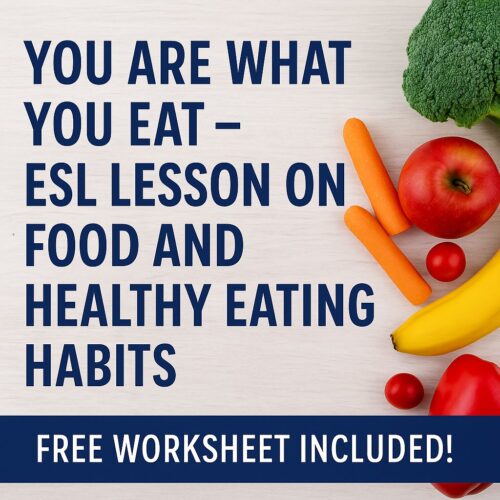ESL lesson on food and healthy eating habits with speaking, grammar, and songs. Includes a free worksheet download for beginner adult learners.

Guess what? When you click and buy through our links, you’re doing more than improving your game. You’re supporting us in a way that doesn’t cost you extra but helps us keep bringing you the best drills and tips. It’s a slam dunk for both of us!
Table of Contents
- Introduction
- What’s the best way to teach food vocabulary and eating habits in an ESL class?
- Common Food Vocabulary for Beginners
- Speaking and Writing About Eating Habits
- Grammar Focus: Count vs. Non-Count Nouns
- Using Songs to Reinforce Learning
- Interactive Practice & Bonus Activities
- Free Worksheet Sample Download
- Full TPT Lesson Access
- Final Thoughts
- Explore More
Food is one of the most relatable and important topics for any English learner. We eat every day, we talk about food constantly, and we often connect with others over meals. Teaching ESL students how to talk about food and their eating habits can unlock conversations, boost vocabulary, and even help them make healthier choices.
What’s the best way to teach food vocabulary and eating habits in an ESL class?
Give students words they can use right away — with real-life food examples, guided speaking practice, and grammar patterns that support confidence.
Common Food Vocabulary for Beginners
This lesson introduces students to basic categories of food: fruits, vegetables, grains, proteins, and snacks. Learners explore these categories through a picture dictionary and a vocabulary chart with pronunciation practice.
Example: “apple,” “rice,” “chicken,” “cookies,” “milk”
Speaking and Writing About Eating Habits
Students ask and answer simple questions about their meals:
- “What do you usually eat for lunch?”
- “What’s your favorite snack?”
- “What food don’t you like?”
They also complete a short writing activity where they describe their own meals using full sentences.
Grammar Focus: Count vs. Non-Count Nouns
Grammar in this lesson is centered on identifying and correctly using count and non-count nouns.
Count nouns are those words that you can actually count. I mean, you can have one apple, two cats, or a million ideas. They’re everywhere! These nouns can be singular or plural, and you’ll often spot them with a number or words like ‘a’ or ‘many’ in front. Remember, an ‘s’ or ‘es’ is usually tacked on for the plural form.
Non-count nouns, on the other hand, are the things you just can’t count. Think water, music, advice—try saying ‘two waters’ and it sounds weird, right? They stay singular, and you won’t pair them with a number. Instead, you’d use terms like ‘some’ or ‘a lot of’ to make sense.
The key difference between these two boils down to whether you can count them. Count nouns come with a precise number, while non-count nouns don’t. Helping verbs and quantifiers change too—’many’ for count nouns and ‘much’ for non-count ones.
Count nouns: an apple, two cookies (you can count these)
Non-count nouns: some rice, a lot of milk (these can’t be counted)
Students practice using “some,” “a,” “any,” “much,” and “many” in context.
Using Songs to Reinforce Learning
Two catchy songs are included:
- “You Are What You Eat” (custom fill-in-the-blank worksheet)
- Bonus Song: “Stop Eating That!” (full lyrics + rhythm activities)
These songs help reinforce vocabulary, rhythm, and pronunciation in a fun, low-pressure way.
Interactive Practice & Bonus Activities
- Partner interviews
- Listening and multiple-choice comprehension
- Realistic role-play script: “Let’s Talk About Food”
- Group memory game
All activities support speaking fluency and practical use of vocabulary.
Free Worksheet Sample Download
Try this 1-page sample from the full lesson:
Includes:
- Vocabulary chart
- Writing prompt
- Count/non-count noun grammar example
Get the Full TPT Lesson
Ready to use the full 90-minute lesson in your classroom or online?
Get the Full Lesson on Teachers Pay Teachers
Includes:
- Editable lesson plan
- 8-page worksheet pack (2 songs included!)
- Printable flashcards
- Role-play activity
- Quiz + answer key
- PDF + DOCX versions of everything
Final Thoughts
Whether you’re teaching online or in person, or if you’re a student working on your own, this food-themed ESL lesson is packed with vocabulary, grammar, conversation, and fun.
You and your students will talk about their eating habits with confidence — and maybe even pick up some healthier choices along the way!
What do you think? What’s your favorite food? Was this lesson helpful.
Have questions or suggestions? I’d love to hear from you. Drop them in the comments!
I always reply.
Explore More
Affiliate Resources for Learners
- Practice with a tutor on italki
- Try Rocket Languages: Learn English Online
- Learn through real conversations: English Class 101
- Fun & fast language app: Mondly Languages


As a former healthcare professional turned stay-at-home mom and ESL enthusiast, I found your “You Are What You Eat” lesson incredibly insightful. The integration of food vocabulary with practical grammar, especially the count vs. non-count nouns, is a brilliant approach that resonates well with adult learners. Adding songs not only makes the learning process enjoyable but also reinforces retention through melody—a technique I’ve found effective in my teaching experiences.
Thank you for providing such a comprehensive and engaging resource; it’s a valuable tool for both educators and learners aiming to make healthy choices while enhancing their English skills.
Hi Alice, thanks for your comments. I’m glad you liked the article/lesson.
KBob